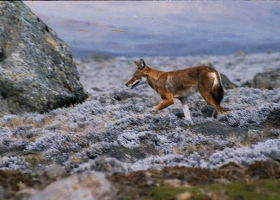Topography of the Bale Mountains
The highest concentrations
of Ethiopian wolves are found in extensive rolling short grasslands and valley
meadows typified by the Sanetti Plateau and Web Valley. These open landscapes
are dominated by the activity of rodents and by frost-induced soil movements.
The burrowing of the giant molerat and cryoturbation keeps the vegetation in permanent
pioneer stages, dominated by short herbs and grasses. These open grasslands support
a high biomass of rodents, in the order of 2,000 - 3,000 kilograms per km².
Wolves are less common on the drier southern declivity of the plateau, in the
rain shadow of Tullu Deemtu (at 4,377m the highest mountain in
southern Ethiopia), and in the lava flows of the Central Peaks
dominated by the less fertile ericaceous moorlands.
Areas below 3,200
m on the northern side of the Bale Mounatins are heavily cultivated with remnant
Juniper forests. To the south large areas of closed canopy montane forest persist
(the Harenna Forest). Hagenia/Hypericum
woodland remnants occurs close to the treeline in all areas between 3,200-3,500
m, grading into heathlands from about 3,400-3,800 m. Afroalpine habitat extends
to the summits. The vegetation along the Web Valley,
which drains a large area in the north eastern part of the range, is exceptional.
A wide valley in the upper part of the drainage at 3,500 m is covered with afroalpine
habitat. Lower down at 3,000 m edaphic grasslands in the Gaysay
Valley provides wolf habitat at an unusually low elevation.
The Bale Mountains are home to the largest of the populations of two Ethiopian
endemics: the mountain Nyala (Tragelaphus buxtoni) , the Ethiopian wolf, Menelik's
Bushbuck as well as the latter’s varied rodent prey, of which many
are locally evolved Oromo people and their livestock
live in or use these mountains and some cultivation occurs in most areas up to
3,500 m. In core wolf areas in the upper Web Valley plowing has been tried but
has not persisted. In the Web valley there are permanent settlements of pastoralists
and houses as high as 4,000 m in other areas. People and livestock travel across
the mountains, visiting the mineral rich springs called horas
These elegant,
long-legged wolves are only found in a handful of scattered mountains in Ethiopia.
Some 500 survive today in small populations, threatened by loss of high altitude
habitats, disease and persecution.
| Mammals | ||
|---|---|---|
| Menelik’s
bushbuck mountain nyala Ethiopian wolf baboon colobus monkey vervet monkey warthog | klipspringer duiker rock hyrax Abyssinian hare side-striped jackal aardvark porcupine | leopard bohor reedbuck serval cat civet cat white-tailed mongoose wild pig spotted hyena |
Other Endemic mammals found in the Bale Mountains
- Dendromus lovati - Lovat's mouse
- Megadendromus nikolausi - Nikolaus' mouse
- Mus mahomet - Mahomet's mouse
- Praomys albipes- white-footed rat
- Stenocephalemys albocaudata - white-tailed rat
- Stenocephalemys griseicauda - grey-tailed rat
- Arvicanthis blicki - Blick's grass rat
- Lophuromys melanonyx - black-clawed mouse
- Tachyoryctes macrocephalus - giant molerat
- Lepus starki - Stark's hare
- Canis simensis - Ethiopian wolf
- Tragelaphus buxtoni- mountain nyala


